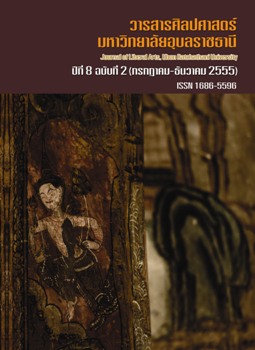Ethnophathogenicity, Ethnophysiology and Herbal Medicine A Case Study of a Traditional Healer in Phitsanulok Province
Main Article Content
บทคัดย่อ
For this research, a purposive qualitative ethnopathogenecity and
ethnophysiology of a long experienced Thai traditional healer in Phisanulok province was carried out. The Ethnopathogenecity which explained the concepts of illness could be divided into two groups (1) The illness caused by the supernatural power and (2) from natural power. For the concept of Ethnophysiology illness caused by imbalance of 6 body systems which could not be separated from each other, and contain stomach, heart, gastrointestinal tract, blood, feet and blood vessels. The recipes of herbal medicine commonly used were (1) tonic (2) drug for gastrointestinal tract (3) drug for diseases of the prostate gland (4) drug for the chronic illness of the testes (5) drug for chest discomfort (6) anti cough, antipyretic, anti sore throat (7) anti malarial drug (8) anti herpes zoster, herpes simplex (9) constipation and (10) immune stimulant. Medical ingredients which were used for these recipes could be divided into three groups i.e.- plants, animal and minerals. Herbs were found in 47 kinds from 34 species. Herb which used for these recipes could be divided into 3 groups i.e.- plants, animal and minerals. The most common used were GRAMINEAE 6, ZINGIBERACEAE, PIPERACEAE and RUTACEAE 3, all the rest were 1-2 kinds in various species. Using animal was one species, and mineral were two kinds.
แนวคิดเกี่ยวกับสาเหตุการเกิดโรคแบบพื้นบ้านแนวคิดเกี่ยวกับกายวิภาคและสรีระวิทยาพื้นบ้านและยาสมุนไพร: กรณีศึกษาหมอพื้นบ้านคนหนึ่ง ในจังหวัดพิษณุโลก
การศึกษาเชิงคุณภาพเกี่ยวกับสาเหตุการเกิดโรคและแนวคิดกายวิภาคและสรีระวิทยาพื้นบ้านครั้งนี้เก็บข้อมูลจากหมอพื้นบ้านท่านหนึ่งที่มีประสบการณ์และความเชี่ยวชาญในการรักษาโรคมาอย่างยาวนาน สำหรับแนวคิดเกี่ยวกับสาเหตุการเกิดโรคแบบพื้นบ้าน พบว่า ความเจ็บป่วยเกิดขึ้นใน 2 มิติใหญ่ๆ คือ (1) การเกิดโรคที่มีสาเหตุมาจากอำนาจเหนือธรรมชาติ และ(2) การเกิดโรคที่มีสาเหตุมาจากอำนาจตามธรรมชาติ สำหรับแนวคิดเกี่ยวกับกายวิภาคและสรีระวิทยาพื้นบ้าน พบว่า ความเจ็บป่วยเกิดขึ้นจากการขาดความสมดุลของระบบอวัยวะที่สำคัญ 6 ประการ คือ กระเพาะอาหาร หัวใจ ลำไส้ เลือด เท้า และเส้นเลือด ส่วนประกอบของร่างกายทั้ง 6 มีความเชื่อมโยงและสัมพันธ์กัน ไม่สามารถแยกออกจากกันได้การรักษาด้วยยาสมุนไพรส่วนใหญ่นิยมจ่ายยาตำรับ ตำรับยาที่สั่งจ่ายบ่อย ประกอบ
ด้วยยาในกลุ่ม(1) ยาบำรุง (ยาอายุวัฒนะ) (2) ยาโรคกระเพาะ (3) ยารักษาต่อมลูกหมาก (4) ยาแก้กษัยลงอัณฑะ (5) ยารักษาโรคสันนิบาตกระตุกในอก (6) ยาแก้ไอ แก้ไขและกวาดคอเด็ก (7)ยารักษาโรคไข้มาลาเรีย (8) ยาแก้งูสวัด ไฟลามทุ่ง เริม (9) ยาแก้ท้องผูก (10) ยาสร้างภูมิต้านทาน
สมุนไพรในภาพรวมที่ใช้ในปรุงยารักษาโรคสามารถแบ่งออกได้ 3 กลุ่ม ประกอบด้วยพืชวัตถุ สัตว์วัตถุและธาตุวัตถุ สมุนไพรที่เป็นพืชวัตถุพบทั้งสิ้น 47 ชนิด จาก 34 วงศ์ สมุนไพรที่ใช้มากที่สุดจัดอยู่ในวงศ์ GRAMINEAE พบทั้งสิ้น 6 ชนิด, ZINGIBERACEAE, PIPERACEAEและ RUTACEAE พบทั้งสิ้นอย่างละ 3 ชนิด นอกนั้นเป็นวงศ์ปลีกย่อยต่างๆ อย่างละ 1-2 ชนิดสมุนไพรที่เป็นสัตว์วัตถุพบ 1 ชนิด และสมุนไพรที่เป็นเป็นธาตุวัตถุพบ 2 ชนิด


